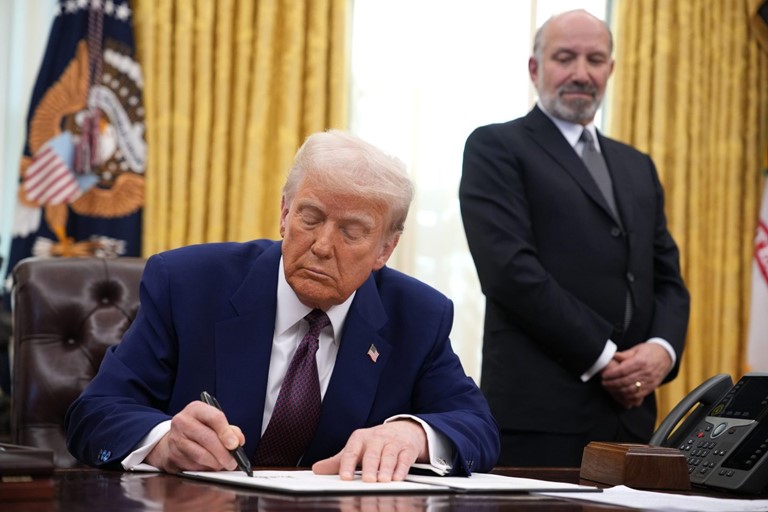
? 特朗普政府正準(zhǔn)備繞過國(guó)會(huì),單方面上調(diào)美國(guó)進(jìn)口大多數(shù)輕型新車2.5%的關(guān)稅,。過去5年中,,新車成本已經(jīng)增長(zhǎng)的20%,此舉可能會(huì)讓新車價(jià)格再次承壓,。
就在消費(fèi)者看到新車價(jià)格終將走向平穩(wěn)的曙光之后,,特朗普總統(tǒng)卻威脅再度抬升其價(jià)格。
上周五,,新一屆政府稱,,3月12日即將生效的鋼鐵和鋁關(guān)稅只是總統(tǒng)的熱身而已,接下來(lái)就是汽車行業(yè),。特朗普總統(tǒng)可能會(huì)上調(diào)轎車和SUV這類進(jìn)口輕型車的關(guān)稅,,其當(dāng)前稅率僅為車價(jià)的2.5%(北美之外地區(qū)產(chǎn)皮卡車的關(guān)稅稅率一直以來(lái)都是25%)。當(dāng)被問及美國(guó)將于何時(shí)全面上調(diào)乘用車的關(guān)稅時(shí),,特朗普稱將在數(shù)周后就運(yùn)作此事,。
“可能在4月2日左右”,這位總統(tǒng)邊說(shuō)邊看向了商務(wù)部長(zhǎng)提名人霍華德·盧特尼克,。后者確認(rèn)說(shuō):“對(duì)”,。
盧特尼克的任命即已于2月18日獲參議院批準(zhǔn),他的首個(gè)任務(wù)是為所謂的232條款調(diào)查進(jìn)行總結(jié),,并報(bào)告乘用車的進(jìn)口為什么會(huì)威脅到國(guó)家安全,。此舉或?qū)⒆尠讓m有能力繞開國(guó)會(huì),并上調(diào)不屬于行政部門權(quán)限的關(guān)稅,。
特朗普還表示:“不管你信不信,,我本可以在4月1日?qǐng)?zhí)行的,[但]我有點(diǎn)迷信,?!辈贿^,特朗普還未公布本屆政府正在籌劃的關(guān)稅加征范圍,。
關(guān)稅由美國(guó)消費(fèi)者買單,,而不是外國(guó)制造商
盡管特朗普此次當(dāng)選背后有諸多原因,但其競(jìng)選活動(dòng)的一項(xiàng)重要主張就是承諾讓不斷高企的國(guó)債回歸掌控,,同時(shí)創(chuàng)造更多的藍(lán)領(lǐng)工作,,而這些崗位此前都被外包給了墨西哥和中國(guó)這樣的低薪資國(guó)家。
他的一石二鳥解決方案便是提升關(guān)稅,,這樣既能補(bǔ)充國(guó)庫(kù),,又能鼓勵(lì)本國(guó)制造業(yè),。不過,此舉與他的另一個(gè)重要承諾相沖突,,即應(yīng)對(duì)生活成本危機(jī),。
就像他在2016年向選民承諾在南部邊境筑墻然后讓墨西哥買單一樣,特朗普讓眾多美國(guó)民眾相信,,調(diào)高關(guān)稅不會(huì)對(duì)他們帶來(lái)任何影響,,因?yàn)檫@一切完全由外國(guó)人買單。
事實(shí)上,,各國(guó)都在努力游說(shuō)美國(guó)政府,,以避免進(jìn)口關(guān)稅的上漲,不過這完全是因?yàn)榱硗庖粋€(gè)原因:關(guān)稅的上調(diào)會(huì)削弱日本,、韓國(guó)和德國(guó)產(chǎn)汽車在市場(chǎng)上的競(jìng)爭(zhēng)力,,而且在一段時(shí)間后會(huì)導(dǎo)致這些國(guó)家工作崗位的消失。
然而,,實(shí)際成本則由口岸的商品進(jìn)口商承擔(dān),,然后通常再轉(zhuǎn)嫁給客戶。這種事情并非只發(fā)生在進(jìn)口領(lǐng)域,。本土制造商也有意效仿其外國(guó)競(jìng)爭(zhēng)對(duì)手,,因?yàn)樗麄冎雷约嚎梢蕴岣呤蹆r(jià)并從中獲取更高的利潤(rùn),而且無(wú)需擔(dān)心丟失市場(chǎng)份額,。
汽車是疫情后時(shí)代通脹的一個(gè)主要推手
這意味著美國(guó)民眾可能很快將迎來(lái)新車售價(jià)的再次上漲,,尤其是3月12日生效的鋼鐵和鋁關(guān)稅還會(huì)推高福特和特斯拉這類本土汽車生產(chǎn)商的汽車出廠價(jià)格。
在過去10年中,,新輕型汽車的平均售價(jià)經(jīng)歷了大幅變化,。在最初的5年中,其價(jià)格的波動(dòng)幅度較窄,,在該時(shí)期結(jié)束時(shí)也就略漲了0.5個(gè)百分點(diǎn),。
然而相比之下,,其增幅在接下來(lái)的5年中高達(dá)20%,。新車與二手車一道,成為了1981年以來(lái)美國(guó)多輪創(chuàng)紀(jì)錄高通脹的一個(gè)主要推手,。
上述價(jià)格增幅源于多個(gè)因素,,包括讓特斯拉這類高端電動(dòng)汽車成為主流暢銷車型的科技革新。然而最重要的是,,該增幅的另一個(gè)推手是芯片短缺,,它導(dǎo)致了新車穩(wěn)定的供應(yīng)戛然而止。
在埃隆·馬斯克意識(shí)到新上馬產(chǎn)能高出了實(shí)際需求并開始發(fā)動(dòng)令人不寒而栗的價(jià)格戰(zhàn)不久之后,,新車價(jià)格在2023年9月達(dá)到了頂峰,。不過總的來(lái)說(shuō),車價(jià)依然高于此前水平。(財(cái)富中文網(wǎng))
譯者:馮豐
審校:夏林
? 特朗普政府正準(zhǔn)備繞過國(guó)會(huì),,單方面上調(diào)美國(guó)進(jìn)口大多數(shù)輕型新車2.5%的關(guān)稅,。過去5年中,新車成本已經(jīng)增長(zhǎng)的20%,,此舉可能會(huì)讓新車價(jià)格再次承壓,。
就在消費(fèi)者看到新車價(jià)格終將走向平穩(wěn)的曙光之后,特朗普總統(tǒng)卻威脅再度抬升其價(jià)格,。
上周五,,新一屆政府稱,3月12日即將生效的鋼鐵和鋁關(guān)稅只是總統(tǒng)的熱身而已,,接下來(lái)就是汽車行業(yè),。特朗普總統(tǒng)可能會(huì)上調(diào)轎車和SUV這類進(jìn)口輕型車的關(guān)稅,其當(dāng)前稅率僅為車價(jià)的2.5%(北美之外地區(qū)產(chǎn)皮卡車的關(guān)稅稅率一直以來(lái)都是25%),。當(dāng)被問及美國(guó)將于何時(shí)全面上調(diào)乘用車的關(guān)稅時(shí),,特朗普稱將在數(shù)周后就運(yùn)作此事。
“可能在4月2日左右”,,這位總統(tǒng)邊說(shuō)邊看向了商務(wù)部長(zhǎng)提名人霍華德·盧特尼克,。后者確認(rèn)說(shuō):“對(duì)”。
盧特尼克的任命即已于2月18日獲參議院批準(zhǔn),,他的首個(gè)任務(wù)是為所謂的232條款調(diào)查進(jìn)行總結(jié),,并報(bào)告乘用車的進(jìn)口為什么會(huì)威脅到國(guó)家安全。此舉或?qū)⒆尠讓m有能力繞開國(guó)會(huì),,并上調(diào)不屬于行政部門權(quán)限的關(guān)稅,。
特朗普還表示:“不管你信不信,我本可以在4月1日?qǐng)?zhí)行的,,[但]我有點(diǎn)迷信,。”不過,,特朗普還未公布本屆政府正在籌劃的關(guān)稅加征范圍,。
關(guān)稅由美國(guó)消費(fèi)者買單,而不是外國(guó)制造商
盡管特朗普此次當(dāng)選背后有諸多原因,,但其競(jìng)選活動(dòng)的一項(xiàng)重要主張就是承諾讓不斷高企的國(guó)債回歸掌控,,同時(shí)創(chuàng)造更多的藍(lán)領(lǐng)工作,而這些崗位此前都被外包給了墨西哥和中國(guó)這樣的低薪資國(guó)家,。
他的一石二鳥解決方案便是提升關(guān)稅,,這樣既能補(bǔ)充國(guó)庫(kù),又能鼓勵(lì)本國(guó)制造業(yè),。不過,,此舉與他的另一個(gè)重要承諾相沖突,,即應(yīng)對(duì)生活成本危機(jī)。
就像他在2016年向選民承諾在南部邊境筑墻然后讓墨西哥買單一樣,,特朗普讓眾多美國(guó)民眾相信,,調(diào)高關(guān)稅不會(huì)對(duì)他們帶來(lái)任何影響,因?yàn)檫@一切完全由外國(guó)人買單,。
事實(shí)上,,各國(guó)都在努力游說(shuō)美國(guó)政府,以避免進(jìn)口關(guān)稅的上漲,,不過這完全是因?yàn)榱硗庖粋€(gè)原因:關(guān)稅的上調(diào)會(huì)削弱日本,、韓國(guó)和德國(guó)產(chǎn)汽車在市場(chǎng)上的競(jìng)爭(zhēng)力,而且在一段時(shí)間后會(huì)導(dǎo)致這些國(guó)家工作崗位的消失,。
然而,,實(shí)際成本則由口岸的商品進(jìn)口商承擔(dān),然后通常再轉(zhuǎn)嫁給客戶,。這種事情并非只發(fā)生在進(jìn)口領(lǐng)域,。本土制造商也有意效仿其外國(guó)競(jìng)爭(zhēng)對(duì)手,因?yàn)樗麄冎雷约嚎梢蕴岣呤蹆r(jià)并從中獲取更高的利潤(rùn),,而且無(wú)需擔(dān)心丟失市場(chǎng)份額,。
汽車是疫情后時(shí)代通脹的一個(gè)主要推手
這意味著美國(guó)民眾可能很快將迎來(lái)新車售價(jià)的再次上漲,尤其是3月12日生效的鋼鐵和鋁關(guān)稅還會(huì)推高福特和特斯拉這類本土汽車生產(chǎn)商的汽車出廠價(jià)格,。
在過去10年中,,新輕型汽車的平均售價(jià)經(jīng)歷了大幅變化。在最初的5年中,,其價(jià)格的波動(dòng)幅度較窄,,在該時(shí)期結(jié)束時(shí)也就略漲了0.5個(gè)百分點(diǎn)。
然而相比之下,,其增幅在接下來(lái)的5年中高達(dá)20%,。新車與二手車一道,成為了1981年以來(lái)美國(guó)多輪創(chuàng)紀(jì)錄高通脹的一個(gè)主要推手,。
上述價(jià)格增幅源于多個(gè)因素,,包括讓特斯拉這類高端電動(dòng)汽車成為主流暢銷車型的科技革新。然而最重要的是,,該增幅的另一個(gè)推手是芯片短缺,,它導(dǎo)致了新車穩(wěn)定的供應(yīng)戛然而止,。
在埃隆·馬斯克意識(shí)到新上馬產(chǎn)能高出了實(shí)際需求并開始發(fā)動(dòng)令人不寒而栗的價(jià)格戰(zhàn)不久之后,,新車價(jià)格在2023年9月達(dá)到了頂峰。不過總的來(lái)說(shuō),,車價(jià)依然高于此前水平,。(財(cái)富中文網(wǎng))
譯者:馮豐
審校:夏林
? The Trump administration is preparing to bypass Congress and unilaterally increase the 2.5% duty levied on most new light-duty vehicles imported into the United States. This could reignite inflationary pressure on new cars that have spiked in cost by 20% over the past five years.
Just when consumers had hoped the price of new cars would finally stabilize, President Donald Trump is threatening to hike them again.
On Friday, the new administration said the president was just warming up with his steel and aluminum tariffs, which take effect on March 12. Next up is the auto industry, where he could raise import duties that currently rest at just 2.5% of the value of imported light-duty vehicles like sedans and SUVs (pickup trucks built outside of North America have long been subject to 25% tariffs).
Asked when the industry could expect higher duties on passenger cars across the board, Trump said he was planning to level the boom in a matter of weeks.
“Maybe around April 2nd,” the president said, looking to his commerce secretary nominee, Howard Lutnick, who confirmed, “That’s right.”
Soon to be confirmed today by the Senate, Lutnick’s first task will be to finalize the so-called Section 232 investigation and report how the import of passenger cars poses a risk to national security. This could enable the White House to bypass Congress and levy tariffs that are not under the executive branch’s purview.
“I would have done them on April 1st, believe it or not, [but] I’m a little superstitious,” added Trump, who didn’t yet reveal the extent of the tariff hikes his government is planning.
American consumers pay for tariffs, not foreign manufacturers
While Trump was elected for a number of reasons, a key plank of his campaign was a promise to bring the spiraling national debt under control while jump-starting more blue-collar jobs that had been outsourced to low-wage countries like Mexico and China, among others.
His solution to both—hiking import tariffs to fill government coffers and encourage domestic manufacturing—clashes with another important pledge: tackling the cost-of-living crisis.
Much like his 2016 pitch to voters he would build a wall on the southern border and get Mexico to pay for it, Trump convinced many Americans it won’t cost them anything since it would all conveniently be borne by foreigners.
While countries do in fact lobby very hard to avoid higher import duties, that is owing to another reason entirely. Higher tariffs make Japanese-, Korean-, and German-built cars, for example, less competitive in the marketplace, leading over time to the loss of jobs in these countries.
The actual cost, however, is paid by the business importing the goods at the border and then typically passed on to the customer. This isn’t limited to imports, either. Domestic manufacturers tend to follow their foreign competitors, knowing they can hike prices and pocket the higher profits without risking a loss of market share.
Cars were a major factor driving inflation post-COVID
That means Americans can likely soon expect the cost of their newly purchased car will be inching up again, especially as the March 12th tariffs on steel and aluminum also drive factory gate inflation at domestic carmakers such as Ford and Tesla.
Over the past 10 years, the average price of a new light vehicle has already experienced a remarkable change. During the first five, they fluctuated in a narrow band, ultimately edging half a percentage point higher at the end of the period.
In the subsequent five years that followed, however, they surged 20% by comparison. Together with used cars, they were a major factor contributing to the pace of inflation hitting highs not seen since November 1981.
This surge in price stemmed from a number of factors, including technological shifts that saw premium EVs like Teslas reach mainstream popularity. First and foremost, however, the surge resulted from a semiconductor shortage that brought the steady supply of new automobiles to a screeching halt.
Prices for new cars peaked in September 2023, shortly after Elon Musk began to launch a debilitating industrywide price war after realizing he built more factory capacity than he had in actual demand. But overall, they remain at elevated levels.






